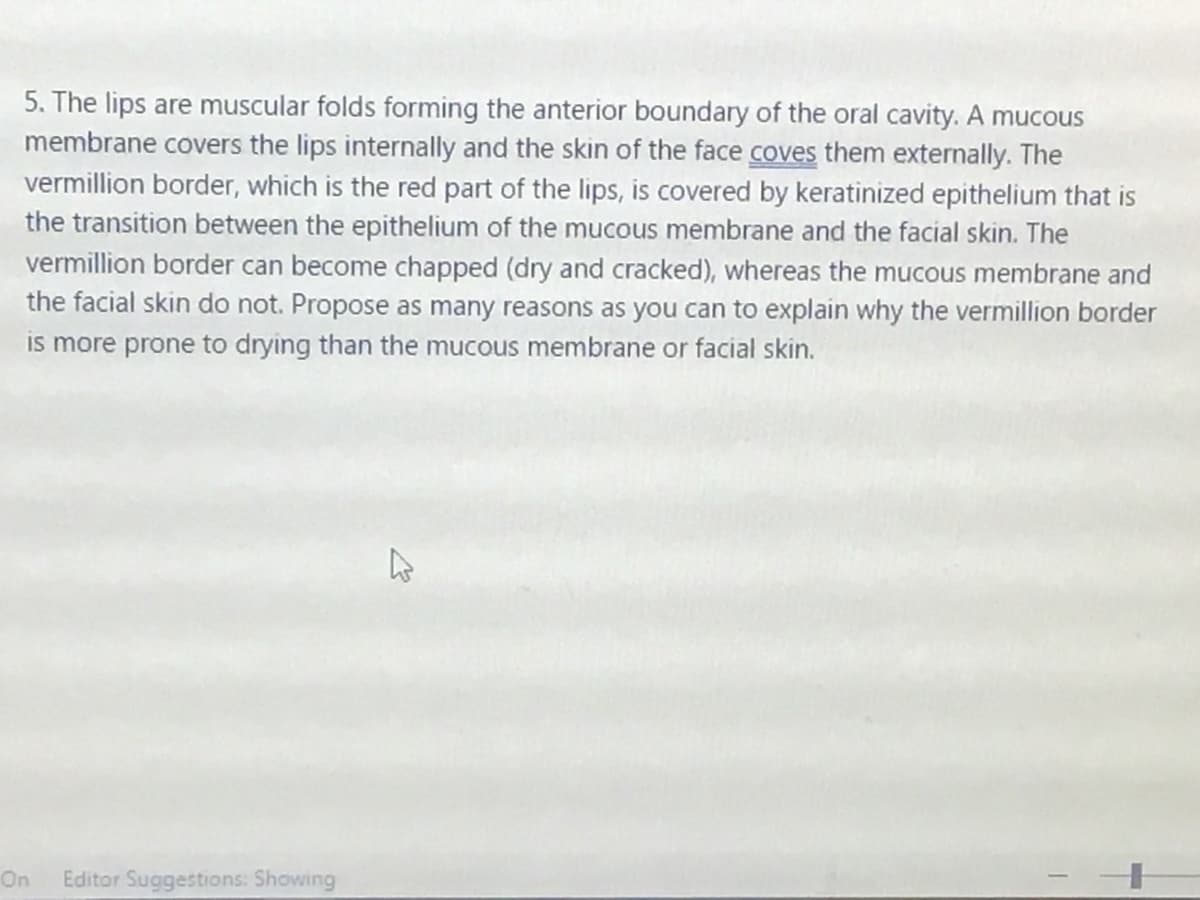5. The lips are muscular folds forming the anterior boundary of the oral cavity. A mucous membrane covers the lips internally and the skin of the face coves them externally. The vermillion border, which is the red part of the lips, is covered by keratinized epithelium that is the transition between the epithelium of the mucous membrane and the facial skin. The vermillion border can become chapped (dry and cracked), whereas the mucous membrane and the facial skin do not. Propose as many reasons as you can to explain why the vermillion border is more prone to drying than the mucous membrane or facial skin. On Editor Suggestions: Showing K hs
5. The lips are muscular folds forming the anterior boundary of the oral cavity. A mucous membrane covers the lips internally and the skin of the face coves them externally. The vermillion border, which is the red part of the lips, is covered by keratinized epithelium that is the transition between the epithelium of the mucous membrane and the facial skin. The vermillion border can become chapped (dry and cracked), whereas the mucous membrane and the facial skin do not. Propose as many reasons as you can to explain why the vermillion border is more prone to drying than the mucous membrane or facial skin. On Editor Suggestions: Showing K hs
Human Anatomy & Physiology (11th Edition)
11th Edition
ISBN:9780134580999
Author:Elaine N. Marieb, Katja N. Hoehn
Publisher:Elaine N. Marieb, Katja N. Hoehn
Chapter1: The Human Body: An Orientation
Section: Chapter Questions
Problem 1RQ: The correct sequence of levels forming the structural hierarchy is A. (a) organ, organ system,...
Related questions
Question
Answer this with essay

Transcribed Image Text:5. The lips are muscular folds forming the anterior boundary of the oral cavity. A mucous
membrane covers the lips internally and the skin of the face coves them externally. The
vermillion border, which is the red part of the lips, is covered by keratinized epithelium that is
the transition between the epithelium of the mucous membrane and the facial skin. The
vermillion border can become chapped (dry and cracked), whereas the mucous membrane and
the facial skin do not. Propose as many reasons as you can to explain why the vermillion border
is more prone to drying than the mucous membrane or facial skin.
On Editor Suggestions: Showing
K
hs
Expert Solution
This question has been solved!
Explore an expertly crafted, step-by-step solution for a thorough understanding of key concepts.
Step by step
Solved in 3 steps

Recommended textbooks for you

Human Anatomy & Physiology (11th Edition)
Anatomy and Physiology
ISBN:
9780134580999
Author:
Elaine N. Marieb, Katja N. Hoehn
Publisher:
PEARSON

Anatomy & Physiology
Anatomy and Physiology
ISBN:
9781259398629
Author:
McKinley, Michael P., O'loughlin, Valerie Dean, Bidle, Theresa Stouter
Publisher:
Mcgraw Hill Education,

Human Anatomy
Anatomy and Physiology
ISBN:
9780135168059
Author:
Marieb, Elaine Nicpon, Brady, Patricia, Mallatt, Jon
Publisher:
Pearson Education, Inc.,

Human Anatomy & Physiology (11th Edition)
Anatomy and Physiology
ISBN:
9780134580999
Author:
Elaine N. Marieb, Katja N. Hoehn
Publisher:
PEARSON

Anatomy & Physiology
Anatomy and Physiology
ISBN:
9781259398629
Author:
McKinley, Michael P., O'loughlin, Valerie Dean, Bidle, Theresa Stouter
Publisher:
Mcgraw Hill Education,

Human Anatomy
Anatomy and Physiology
ISBN:
9780135168059
Author:
Marieb, Elaine Nicpon, Brady, Patricia, Mallatt, Jon
Publisher:
Pearson Education, Inc.,

Anatomy & Physiology: An Integrative Approach
Anatomy and Physiology
ISBN:
9780078024283
Author:
Michael McKinley Dr., Valerie O'Loughlin, Theresa Bidle
Publisher:
McGraw-Hill Education

Human Anatomy & Physiology (Marieb, Human Anatomy…
Anatomy and Physiology
ISBN:
9780321927040
Author:
Elaine N. Marieb, Katja Hoehn
Publisher:
PEARSON